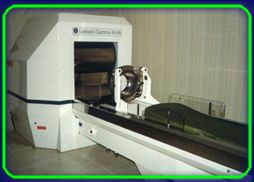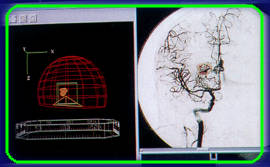|
1. What
is Gamma Knife?
2.
In
how many places over the world is there Gamma Knife?
3.
Who
performs the surgery with Gamma Knife?
4.
What
kind of ailments may be handled with Gamma Knife?
5.
What
are the most important advantages offered by Gamma Knife?
6.
Does
the patient benefit thanks to the surgery with Gamma Knife?
7.
How
can the procedure with Gamma Knife be compared with that of craniotomy/microsurgery?
8.
How
is the procedure with Gamma Knife?
9.
Has Gamma Knife been enough tested, as a therapeutic method, and what
have the clinical results been?
10.
Where
can I find more information about Gamma Knife?
 1.
What is Gamma Knife? 1.
What is Gamma Knife?
Gamma Knife is a high-precision instrument, which sends sub-millimetrically
focused radiation to some brain lesions, treating them in such a way,
that the patient does not have to undergo a craniotomy, that is, a conventional
operation. The method, called Radiosurgery with Gamma Knife, offers
very important advantages to the patients. It may be used as the only
treatment, or as a complementary handling after the procedures performed
with microsurgery.
2. In
how many places over the world is there Gamma Knife?
More than 100; however, the Gamma Knife Unit of Hospital San Javier
is one of the only two ones currently working in Latin America.
3. Who
performs the surgery with Gamma Knife?
The "surgery" with Gamma Knife is performed by a multidisciplinary
staff including, among many other people, a neurosurgeon, a radio-oncologist,
physicists, technicians, and nurses, who are all trained for this kind
of procedures at education centers with an international quality level.
4. What
kind of ailments may be handled with Gamma Knife?
The indications for Gamma Knife include mainly tumors and vascular malformations.
As examples, we could mention: menigiomata, acoustic neurinomata, gliomata,
tumors in the pineal region, some malignant cerebral tumors, partially
resected tumors, pituitary adenomata, trigeminal neuralgia, etc. Potential
indications would be: epilepsy, untreatable pain, and Parkinson's disease.
5. What
are the most important advantages offered by Gamma Knife?
First, the astonishing results obtained as for sucessful treatments
of extremely risky pathologies representing a technical difficulty,
and second, it requires a minimal stay
at the hospital, since most of the patients may leave the hospital after
twenty-four hours of observation, allowing thus the patient to reintegrate
to the daily tasks surprisingly soon.
 6.
Does
the patient benefit thanks to the surgery with Gamma Knife? 6.
Does
the patient benefit thanks to the surgery with Gamma Knife?
Of course, for example: an outstanding reduction of the complication
possibilities, an extraordinarily quick recovery with a very brief convalescence
period, absence of pain during the procedure, only one treatment session,
and a mortality rate of practically 0%.
7. How
can the procedure with Gamma Knife be compared with that of craniotomy/microsurgery?
There are many differences between surgery with Gamma Knife and microsurgery.
The most important differences are:
Microsurgery
- 5 to 10 days of stay at the hospital
- 2 to 3 days of intensive therapy
- 4 to 6 weeks of convalescence
- Invasive procedure
- Risk of hemorrhage, infection, and other post-operative complications
- Limitation of access to deep lesions
Gamma Knife
- One night of stay at the hospital
- No intensive therapy
- Quick return to the pre-operative way of life
- Non-invasive procedure
- Minimal immediate post-operative risks
- Excellent acces to any area of the brain
8. How
is the procedure with Gamma Knife?
The procedure of surgery with Gamma Knife lasts from 2 to 4 hours, and
it consists of 4 basic steps:
Positioning of Frame: An stereotactic
frame is adjusted around the patient's head. It is used to locate the
lesion with a great exactitude.
Obtaining of images: The images
of magnetic resonance, computerized axial tomography, and arteriography
are taken when the patient has the frame already fixed, in order to
locate and specify the lesion in the clearest way.
Planning of treatment: With the
help of a computer, the multidisciplinary staff defines the appropriate
treatment, conforming the dose according to the lesion's volume, and
thus minimizing the risks.
Treatment: The patient is placed
on the Gamma Knife table. The unit sends only one focused ionized radiation
dose, destroying all the sick cells or stopping their growth. After
the procedure, the patient goes to observation for a period of 24 hours,
after which, he or she may leave the hospital.
9. Has
Gamma Knife
been enough tested, as a therapeutic method,
and what have the clinical results been?
Nowadays, many clinical studies have already been carried
out about Gamma Knife as a therapeutic recourse, and we may say that
the results have been, to date, highly satisfying.
There are more than 100 equipments installed around the world (including
more than 30 in the US), more than 100,000 patients have received the
benefits offered by this recourse, and the expenses are accepted and
reimboursed by the most important insurance companies of the country.
10. Where
can I find more information about Gamma Knife?
For more information, including a complete list of places where there
are equipments installed, revised technology, statistics of treated
patients, and bibliography of published clinical articles, visit the
international network http://www.elekta.com,
or visit us at http://www.sanjavier.com.
|
. |
All the members of our staff
have been trained at education institutes with an international quality
level.
The results reached
as for patients with highly risky pathologies are amazing.
|


